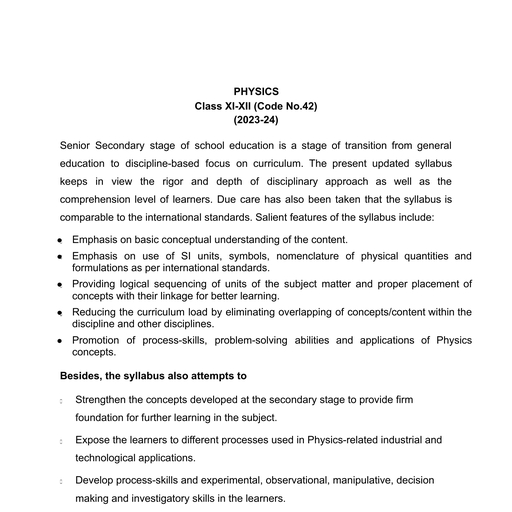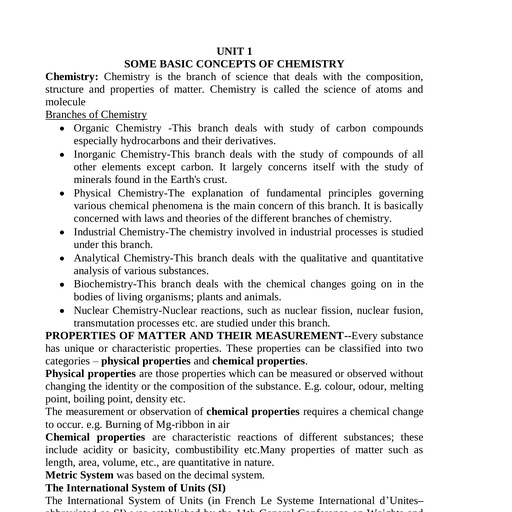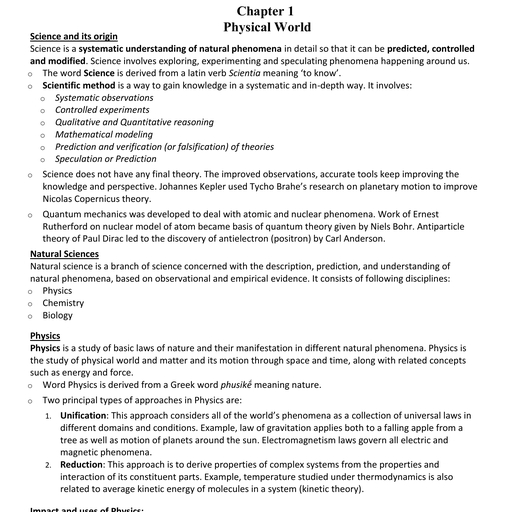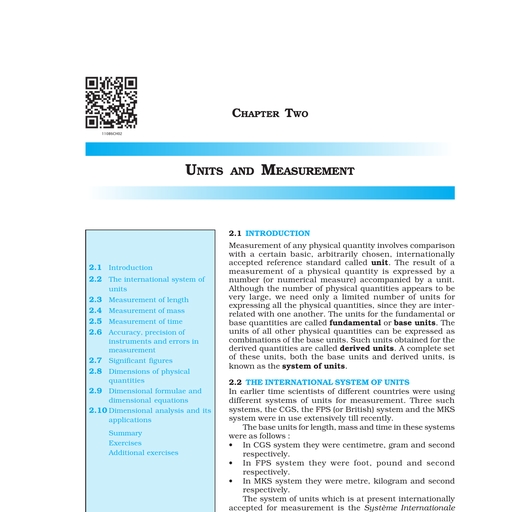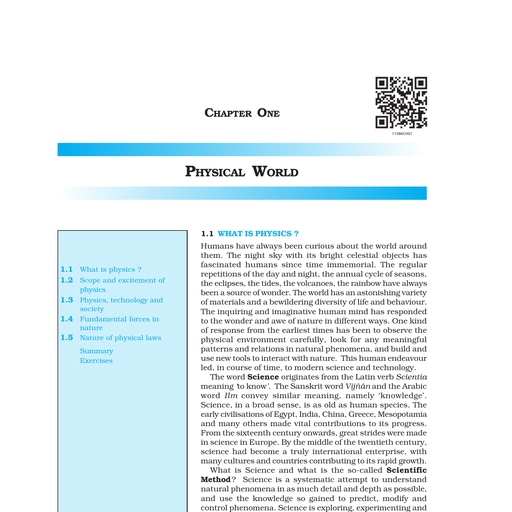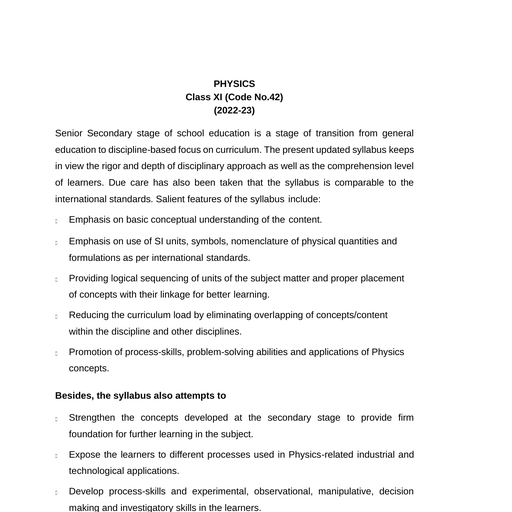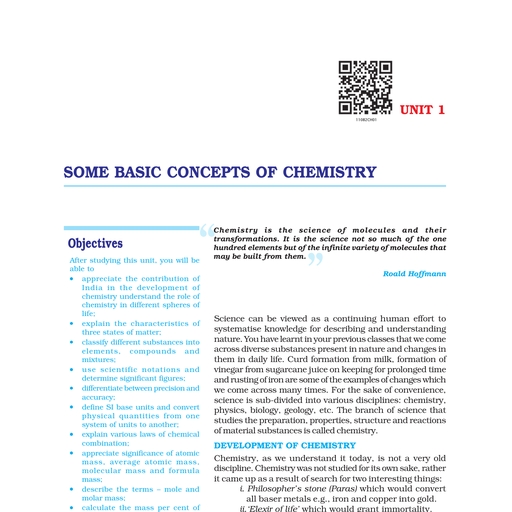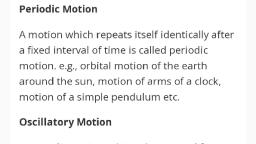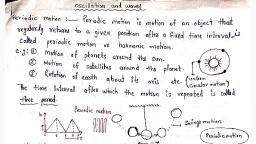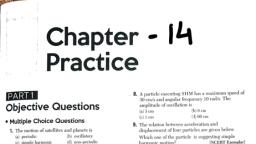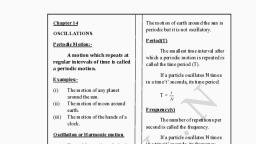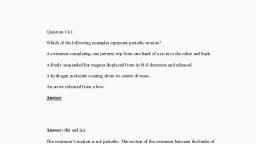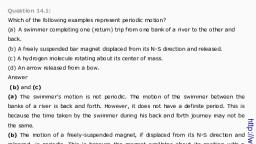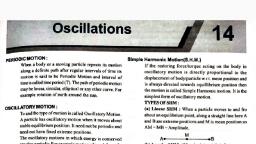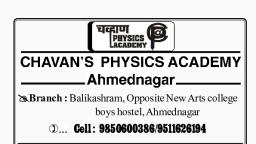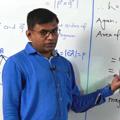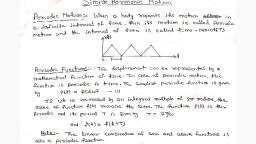Page 1 :
Oscillations, , ————, , , , , , , , 14.1 Which of the following examples represent, periodic motion?, , Sol., , 14.2, , Sol., , (a), ), ©., , @, (a), , (b), , (c), (@), , Aswimmer completing one (return) trip, from one bank of a river to other and back., A freely suspended bar magnet displaced, from its N-S direction and released., , A hydrogen molecule rotating about its, centre of mass., , An arrow released from a bow., , Not a periodic motion as he does not take, a definite time to repeat his motion, , Is a periodic motion as it oscillates about, N-S direction, , Is a periodic motion., , Not a periodic motion., , Which of the following examples represent, (nearly) simple harmonic motion and which, represent periodic but not simple harmonic, motion?, , @), ), , (), , @, , the rotation of earth about its axis., motion of an oscillating mercury column, in a U-tube., , motion of a ball bearing inside a smooth, curved bowl, when released from a point, slightly above the lower most point., general vibrations of a polyatomic, molecule about its equilibrium position., It is periodic but not SHM because it is, not a to and fro motion about a fixed, point., , S.H.M., , S.H.M., , It is periodic but not 8.H.M., , , , NCERT EXERCISES <3, , 14.3 Figure depicts four x- ¢ plots for linear motion, of a particle. Which of the plots represent, periodic motion? What is the period of motion, (in case of periodic motion)?, , Sol., , 14.4, , (a), , (b), , ©, , @, (a), (b), (c), , (d), , x, , w, o, , , , Non-periodic motion, , Periodic motion, the particle repeats its, entire motion after an interval of 2 seconds, hence period = 2s., , Non-periodic motion as the position is not, retraced in the fixed interval., , Periodic motion with a period of 2s., , Which of the following functions of time, represent, , (a), ), (©), , simple harmonic, periodic but not simple harmonic, and, non-periodic motion ?
Page 2 :
Sol., , Give period for each case of periodic motion, (@ is any positive constant) :, , (a) sinw/ — coset, , (b) sinvar, , (c) seas( nd 201), , (d) cos wf + cos 3@f + cos 5at, , 22, @ e&°*, , () 1+ot+ a?, , (a) sin @f — cos ar, , 1 1, =f —=sin wi -—= cos wf, v2 v2, , . T . 1, = 2 sin (7.COS— — COS @7.SIN —, 4 4, , 4, , It is an SHM and time period is 27/o, , (b) sin'or = — [3siner — sin3of], , Slo, , 2m, It is only periodic but not SHM, T = ot, o, , (c) 3e0s|=—20r] = 3c0s( 201], \4 4, [' cos(—8) = cos 8], It is a periodic motion but not SHM,, _2n, e, (d) cos wf + cos 31 + cos Ser, = cos wf + cos Ser + cos 3cr, , aes) (ose), —— }¢0s| ——, , T, , = 2eos, , + cos 301, = 2cos (2 wt).cos (-2at) + cos 3ar, = cos 3a/(1 + 2cos 2er);, It is periodic with T= 2 1/., , 22, (e) e° is an exponential function which, does not repeat., , It is non-periodic., () 1+ a+ 2? is also non-periodic., , 14.5, , A particle is in linear simple harmonic motion, between two points A and B, 10 cm apart. Take, the direction from A to B as the positive direction, and give the signs of velocity, acceleration and, force on the particle when it is, , (a) atthe end A,, , (b) at the end B,, , (c) at the mid-point of AB going towards A,, (d) at2 cm away from B going towards A,, (e) at3 cmaway from going towards B, and, (f) at 4 cm away from B going towards A., , , , , , , , , , , , , , , , Sol., S.No.| Position ofthe |Sign Sign of |Sign of, particle Velocity | Acceler |force, =ation jon the, particle, a_ |Atthe endA 0(Zero) + +, b JAtthe endB 0 (Zero) = =, At the mid point, © JO going towards | — (Max) 0 0, A, At2cm from B, 7 going towards A ~ ~ ~, At3cmfromA, © going towards B : : ‘, f At4cmfrom A ‘ ‘ ‘, going towards A, , , , , , , , , , , , , , 14.6 Which of the following relationships between, , Sol., , 14.7, , the acceleration a and displacement x of a, particle involve SHM?, , (a) 2=0.7 x, (b) a =— 200x?, (c) a=— 10x @ a=100 x3, In SHM, a «& — x, , (b) and (c) represent SHM., The motion of a particle exccuting SHM is, described by the displacement function,, x (O= A cos (wf + $)., If the initial (¢= 0) position of the particle is, 1 cm and the initial velocity is @ cm/s, what, are its amplitude and initial phase angle? The, angular frequency of the particle is ms~!. If, instead of the cosine function, we choose the, sine function to describe the SHM : x= B sin, (ot + &), what are the amplitude and initial, phase of the particle with the above initial, conditions.
Page 3 :
Sol., , 14.8, , Sol., , 14.9, , Here, ¢= 0, x = | cm, y= cm/s,, o=? w=Ts, x =A cos (at +o) => 1 =A cos, (nm x 0+ 0) = Acos o...(1), , Velocity, v= & =— Aq sin (wt + ), a, , =-Amsin (7x 0+) > 1=-Asind, or Asin d=-1 w. (2), Squaring and adding (1) and (2), A? (cos? b+ sin? 6) =14+1=2, => A =20r A= J2com, Dividing (2) by (1),, , tang =—1 or ¢ = = or is, , 4, For x = B sin (wf + a),, Solving similarly we get B = v2 cm, , T Bi, and phase angle, a 4 or a, A spring balance hasa scale that reads from, 0 to 50 kg. The length of the scale is 20 cm., A body suspended from this balance, when, displaced and released, oscillates with a period, of 0.6s. What is the weight of the body?, Here, m= 50 kg, max. extension = y = 20 — 0, =20cm=0.2 m, T= 0.6 8, Force = F = mg = 50 x 9.8 N, , , , , , F 5 i, k = 50x28 9450 Nim, y 0.2, 2 2, , m Tvk 0.6)" x 2450, , T=2n. : => m=— T= OS) ee, 4n 4x(3.14), = 22.36 kg, , Weight of the body = mg = 22.36*9.8=219.1N, A spring having with a spring constant 1200, Nm! is mounted on a horizontal table as, shown in Fig. A mass of 3 kg is attached to the, free end of the spring. The mass is then pulled, sideways to a distance of 2.0 cm and released., , , , Fig, , Sol., , 14.10, , Sol., , Determine (i) the frequency of oscillations, (ii), maximum acceleration of the mass, and (iii), the maximum speed of the mass., , Given, k= 1200 N/m; m= 3kg; a = 2em=0.02 m, @ F Vagt fe, L Tequen =y= t=, |/—, teney T 2nVin, , , , , , 1 0, 2x3.14V 3, , (ii) Acceleration = oy =, , —y:, , m, , ka _1200x0.02, =— m/, , Max. acceleration = —=, m, , (iit) Max. speed = aw, , , , In Exercise 14.9, let us take the position of, mass when the spring is unstreched as x = 0,, and the direction from left to right as the, positive direction of x-axis. Give x as a, function of time ¢ for the oscillating mass if, at the moment we start the stopwatch (t= 0),, the mass is, , (a) at the mean position,, , (b) atthe maximum stretched position, and, (c) atthe maximum compressed position., In what way do these functions for SHM differ, from each other, in frequency, in amplitude, or the initial phase ?, , k 1200, a=2cem, @ =,/— =,/—, m g, , (a) Since time is measured from mean, position, x = a sin a = 2 sin 204, , (b) At the maximum stretched position, the, body is at the extreme right position. The, , , , =20s7!, , do fot . a, initial phase is ee, , \, 4 T, i= asin{ ov +5) = acosaf = 2cos20/, , (c) At the maximum compressed position,, the body is at the extreme left position., , ag 3x, The initial phase is =, , . 3n), , " X= asin| ot +>] = —acos@t = —2cos 20t, The function neither differ in amplitude nor, in frequency. The function differ only in initial, phase.
Page 4 :
14.11 Following figures correspond to two circular, motions. The radius of the circle, the period, of revolution, the initial position, and the sense, of revolution (i-e., clockwise or anti-clockwise), are indicated on each figure., , , , P= 25 To x, P(r=0), (a), y, Pf 2m T=4s, x, (7=0), (b), , Obtain the corresponding simple harmonic, motions of the x-projection of the radius, vector of the revolving particle P in each case., Sol. (a) Let the radius vector OA is projected at, point B on the diameter of circle and, makes an angle 9 with initial position P., , Thus ZPOA=8= ZBAO, , , , In A OBA, OB = OA sin 8, sin 0 = 3sin a, , , , z, or x= Seino «= and T = 2s, 2 Lf, , x=—3sin m, , (b) Let the radius vector OA is projected at, point B on the diameter of circle and, makes an angle 0 with initial position., , Thus, ZAOB = 6, In, A OBA, , ee =cos0, OA, , , , (!T=4), OB = OA cos 8, , 20, or —x = 2cos—/, 4, , 260g, x = 2008, , 14.12 Plot the corresponding reference circle for, each of the following simple harmonic, motions. Indicate the initial (¢=0) position, of the particle, the radius of the circle, and, the angular speed of the rotating particle. For, simplicity, the sense of rotation may be fixed, to be anti-clockwise in every case:, , (x is in cm and ¢ is in s), (a) x = 2 sin (34 + 2/3), (b) x = cos (1/6 — 1), , (c) x =3 sin (2at + 1/4), @) x=2 cos nt, , x=-2sin(3¢+2) = 2eos(3v+2+2), 3 3.2, , Radius of the reference circle,, r= amplitude of SHM = 2 cm, , 28, At t= 0, x = -2 sin = ae =-J3em, , Sol. (a), , , , Also wt = 3f 2. @ = 3 rad/s, , At é=0 cond) =F 4, = 150°
Page 5 :
(b), , (c), , , , The reference circle is, thus, as plotted Therefore, the reference circle is being, below. shown below., , @ =3 rad/s, , , , @ = 2n rad/s, , , , , , , , (d) x =2 cos at, Radius of reference circle, r= 2 cm and, , x=cos{ 4-1] =cos{ 2] at¢=0,x=2 cm, 6 6) *. Of = Tt, or @ = 7 rad/s, , [-. cos (- 0) = cos 0] cos dy = 1, by) = 0, Radius of circle, r = amplitude of The reference circle is plotted below., , SHM = I cm, , 3, COs 9 ="y 70 7, , , , , , Also ot = If > @ = I rad/s, The reference circle is, thus as plotted 14.13 Figure (a) shows a spring of force constant, below k clamped rigidly at one end and a mass m, w@ = 1 rad/s attached to its free end. A force F applied at, the free end stretches the spring. Figure (b), shows the same spring with both ends free, , 0 Ss and attached to a mass m at either end. Each, 130° end of the spring in Fig. (b) is stretched by, lem /t=0 the same force F., , , , , , k m, x=-Beos{2nr+2+2) LU00000 4 ber, , 2, , , , , , =3sin ( 2m =) [sin 0 — cos(90° +0)], 4 m k mm, , Here, radius of reference circle, r= 3 em Fe LO000000 4 b> F, , , , , , , , , , , , , , , , - 1 8, and at ¢=0, x = 3 la (b), (a) What is the maximum extension of the, ON AR a Amtadis spring in the two cases?, , (b) If the mass in Fig. (a) and the two, ] T masses in Fig. (b) are released, what is, At?=0; cos $9 a “hb => b0 = 4 the period of oscillation in cach case?
